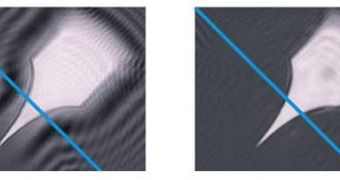New imaging technique brings significant improvements in 3D images of individual molecules. Soon, this discovery might be used by biologists interested in how the shapes of proteins and other components of life relate to their function.
Molecular holograms are an advanced form of photography that allows an image to be recorded in three dimensions. Current holograms are also used to optically store, retrieve and process information for computer technology.
They form a complex interference pattern that is created when laser light reflects off an object, developed by a team of Swiss scientists that used light bouncing off the hologram to recreate the pattern of waves giving the impression that the viewer is looking at the original object in 3D.
Until now, there was one major problem with this imaging technique, the fact that the second image, superimposed on the first, was out of focus, seriously degrading the result. "The twin image problem has existed since holography was conceived. People have always worried about it," says Hans-Werner Fink, a physicist at the University of Zurich in Switzerland.
Now, Fink and his colleague Tatiana Latychevskaia have solved the problem in a way that should work, regardless of the source of illumination.
They discovered the method after observing that the blurry superimposed twin image created some brighter areas of the light field, even brighter than would be possible, were there a single image alone. Then, they created a computer software that identifies these regions, replaces them with a more realistic light level and consequently calculates how this would affect the light field that created them.
The result is a new image, created using this modified light field, and repeating this process many times removes the twin image entirely, dramatically sharpening the result.
Practical applications of this new technique could extend beyond the optical region, to X-rays and electron waves and could eventually lead to precise 3D images of the smallest molecules.

 14 DAY TRIAL //
14 DAY TRIAL //